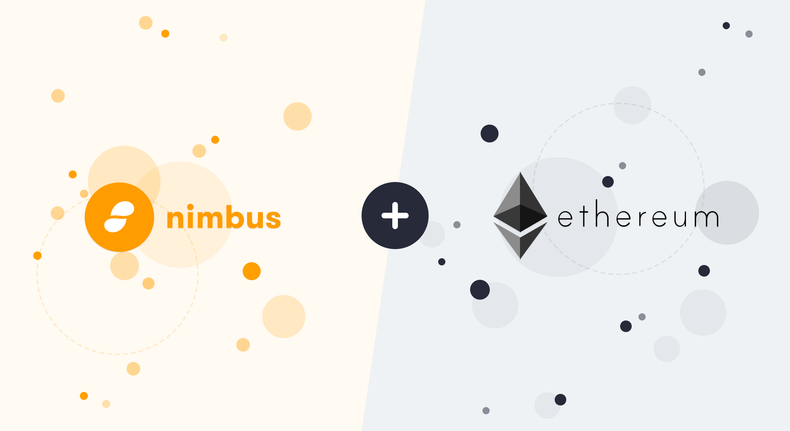The Nimbus team has been awarded $650k to continue work on the completion of a public multi-client ready testnest, further auditing, and preparations for production use.
Zug, Switzerland – January 28, 2020 – Nimbus, an infrastructure project of The Status Network, has been awarded a follow-up grant of $650k by the Ethereum Foundation, bringing their total commitment to date to $1.65 million. The grant will enable the team to continue development of a client implementation for Ethereum 2.0 designed to perform well on embedded systems and personal mobile devices, including older smartphones with resource-restricted hardware.
Nimbus was introduced in March of 2018 by The Status Network as an effort to push the scalability of Ethereum and build a client designed to work well on mobile and embedded systems. In October of 2018, Nimbus was awarded $500k as part of the 4th wave of Ethereum Foundation Scalability Research and Development Subsidy Program. In August, 2019, the Nimbus team was then issued an additional $500k to continue R&D along with $150k by the Ethereum Foundation and Protocol Labs to create an implementation of libp2p focusing on mobile devices as well as future private, secure messaging protocols.
What is Nimbus
Nimbus is a research project and a client implementation for Eth2.0 and light clients addressing the concerns of scalability and wide access of Ethereum. Nimbus is designed to perform well on embedded and personal mobile devices, including older smartphones with resource-restricted hardware. It is also built to be extensible, configurable, and modular. It was first conceived by The Status Network as a means of ensuring the accessibility of the Status Mobile App on a multitude of smartphones.
Nimbus chose to use Nim as the programming language because it is lightweight and therefore well suited to run efficiently on resource-restricted devices. Nimbus has also funded and supported the development of the Nim programming language, creating a strong tie between the implementation and language teams.
Notable Successes
The Nimbus team, comprised of Eugene Kabanov, Andri Lim, Mamy Ratsimbazafy, Yuriy Glukhov, Zahary Karadjov, Dustin Brody, Ștefan Talpalaru, and Kim De Mey, have made great progress since kicking off work in 2018. Emerging as one of the premier Eth2.0 R&D teams in the ecosystem, they have:
- - Implemented the first multi-client finalization with Lighthouse
- - Created a networking spec with Lighthouse
- - Coordinated and setup a single and multi-client public testnet
- - Implemented a rigorous testing platform covering all Ethereum Foundation Eth2.0 tests
- - Produced an alpha of a native libp2p implementation written in Nim
- - Continued sponsorship and collaboration with the Nim language, which reached version 1.0 in September 2019
- - Eth1 synced up to Istanbul
- - Created nimplay – an experimental language & framework for eWASM-based smart contracts which is also a candidate for Eth2 Phase2.
- - Presented at devcon5 and other high profile Ethereum conferences, covering topics such as Raspberry PI, developer experience, wasm performance, eth2/libp2p networking, panel attendance, and more
- - First steps towards integration of Nimbus in the Status mobile app – a production use of Nimbus
- - Built with multiple platforms from the start: tested on Win/Mac/Linux - x86/x86_64/ARM - looking to expand to RISC-V, BSD
Upcoming Milestones
The Nimbus team will use these funds to continue development on their client focusing on 3 primary areas, all leading up to and supporting an eventual release of Ethereum 2:
Potential Expansions
The funding allows the Nimbus team to bring on additional engineers who can help broaden the scope of work to key new areas. New hires can expand work to:
- Developing an experimental phase1 implementation and start researching distributed storage solutions for Eth2 light clients
- Addressing execution exploring WASM including testing interpreter vs compiler as well as prototyping Eth1 EE.
- Layer 2 preparations and exploration of implementation space of Eth2 layer 2 - optimistic execution, wasm strategies etc
Jacek Sieka, Head of Research at Nimbus said:
“We have been making good progress on Nimbus and this grant enables us to not only continue our R&D of the Eth2.0 client, but also explore additional areas of focus which can make Nimbus an even more versatile and important piece of infrastructure and accelerate the upcoming development phases.”
Get Involved
The Nimbus client is entirely open source and open to contribution and testing from those who want to get involved. Learn more about Nimbus, the team and ways to get involved at nimbus.team.
Check out the documentation and repos on Github.
Join the conversation on Discord
About The Status Network
Nimbus is part of the The Status Network – a globally distributed collective working to build products, tools and infrastructure for resilient, sustainable and inclusive communities:
- At the product layer, the Network includes Status App for communication, Keycard for an open payment network, and decentralized financial tools including Assemble and Teller.
- At the developer tools layer, the Network supports Embark and Subspace to help developers build decentralized applications.
- At the infrastructure layer, along with Nimbus, The Status Network supports Vac, an R&D initiative creating a modular, peer-to-peer messaging stack for private, secure, censorship resistant communication.
The Status Network team is working in regions to research how to combat financial and political oppression using blockchain and other emerging technologies.




